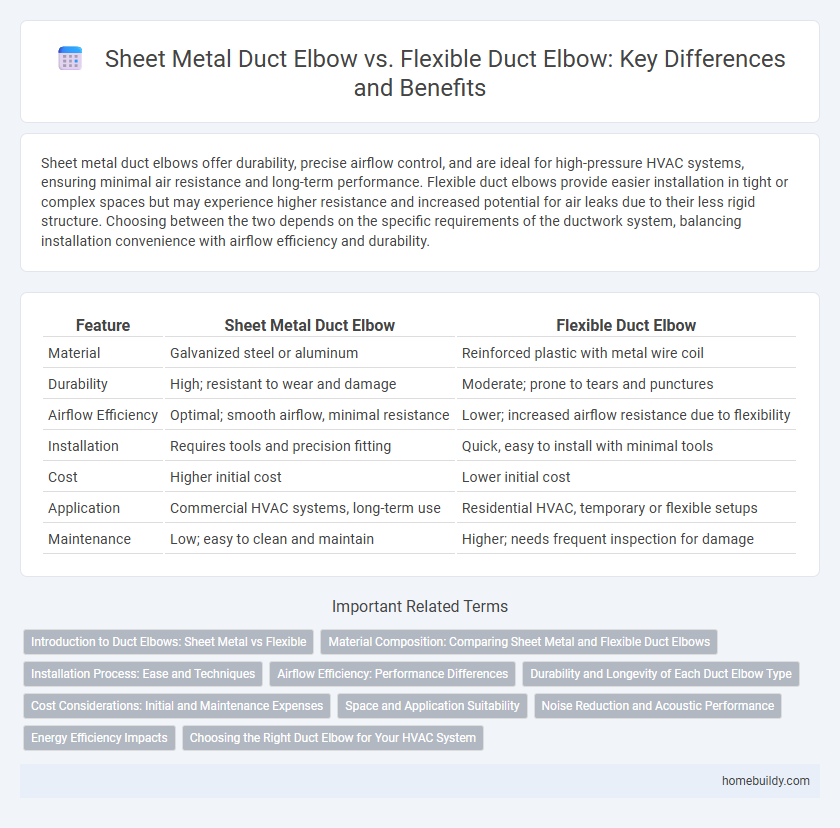Sheet metal duct elbows offer durability, precise airflow control, and are ideal for high-pressure HVAC systems, ensuring minimal air resistance and long-term performance. Flexible duct elbows provide easier installation in tight or complex spaces but may experience higher resistance and increased potential for air leaks due to their less rigid structure. Choosing between the two depends on the specific requirements of the ductwork system, balancing installation convenience with airflow efficiency and durability.
Table of Comparison
| Feature | Sheet Metal Duct Elbow | Flexible Duct Elbow |
|---|---|---|
| Material | Galvanized steel or aluminum | Reinforced plastic with metal wire coil |
| Durability | High; resistant to wear and damage | Moderate; prone to tears and punctures |
| Airflow Efficiency | Optimal; smooth airflow, minimal resistance | Lower; increased airflow resistance due to flexibility |
| Installation | Requires tools and precision fitting | Quick, easy to install with minimal tools |
| Cost | Higher initial cost | Lower initial cost |
| Application | Commercial HVAC systems, long-term use | Residential HVAC, temporary or flexible setups |
| Maintenance | Low; easy to clean and maintain | Higher; needs frequent inspection for damage |
Introduction to Duct Elbows: Sheet Metal vs Flexible
Sheet metal duct elbows provide rigid, durable airflow direction with minimal pressure loss, commonly used in commercial HVAC systems for efficient air distribution. Flexible duct elbows offer adaptability and ease of installation in tight spaces but may result in higher air resistance and potential leakage. Selecting between sheet metal and flexible duct elbows depends on project requirements for airflow efficiency, space constraints, and durability.
Material Composition: Comparing Sheet Metal and Flexible Duct Elbows
Sheet metal duct elbows are typically constructed from galvanized steel or aluminum, offering superior durability, rigidity, and resistance to heat and physical damage. Flexible duct elbows consist of a metal wire helix covered with durable plastic or reinforced with polyester fibers, providing greater flexibility but less structural strength. The choice between these materials impacts airflow efficiency, installation ease, and system longevity in HVAC applications.
Installation Process: Ease and Techniques
Sheet metal duct elbows require precise measurements, cutting, and sealing to ensure airtight connections, relying heavily on skilled labor and specialized tools for installation. Flexible duct elbows offer quicker installation with their bendable, pre-insulated design, enabling easier fitting around obstacles without the need for complex joints or sealing. The installation process of flexible elbows minimizes labor time and reduces potential air leakage compared to the rigid, more labor-intensive sheet metal elbows.
Airflow Efficiency: Performance Differences
Sheet metal duct elbows maintain superior airflow efficiency due to their rigid, smooth surfaces that minimize air resistance and turbulence, enabling consistent, high-velocity air transport. Flexible duct elbows often create increased friction and airflow disruption because of their corrugated design, which can lead to pressure drops and reduced HVAC system performance. Selecting sheet metal elbows enhances overall ventilation effectiveness by optimizing air distribution and reducing energy consumption.
Durability and Longevity of Each Duct Elbow Type
Sheet metal duct elbows offer superior durability due to their rigid construction and resistance to physical damage, ensuring a longer lifespan in HVAC systems. Flexible duct elbows, while easier to install and adjust, are more prone to wear and tear, reducing their longevity compared to sheet metal counterparts. For long-term performance, sheet metal elbows remain the preferred choice in environments subject to frequent mechanical stress.
Cost Considerations: Initial and Maintenance Expenses
Sheet metal duct elbows generally incur higher initial costs due to material and fabrication requirements but offer lower long-term maintenance expenses because of their durability and resistance to damage. Flexible duct elbows tend to have lower upfront costs and quicker installation times but may lead to increased maintenance expenses over time due to wear, tears, and reduced airflow efficiency. Choosing between the two depends on balancing the budget for installation against potential future maintenance and replacement needs.
Space and Application Suitability
Sheet metal duct elbows offer precise airflow control and are ideal for tight spaces due to their rigid structure and customizable angles. Flexible duct elbows provide easier installation in irregular or limited-access areas, but may cause higher airflow resistance and reduced efficiency. Choosing between them depends on space constraints and the specific HVAC application's need for durability and airflow performance.
Noise Reduction and Acoustic Performance
Sheet metal duct elbows offer superior noise reduction due to their rigid structure that minimizes vibration and sound transmission, making them ideal for systems requiring high acoustic performance. Flexible duct elbows, while easier to install, tend to produce more noise because their pliable material allows for increased airflow turbulence and vibration. Selecting sheet metal duct elbows enhances overall acoustic insulation and reduces operational noise in HVAC applications.
Energy Efficiency Impacts
Sheet metal duct elbows offer superior energy efficiency compared to flexible duct elbows due to their smooth interior surfaces that reduce air resistance and minimize pressure drops. Flexible duct elbows, with their corrugated design, create turbulence and increased friction, leading to higher energy consumption by HVAC systems. Optimizing ductwork with sheet metal elbows can significantly lower operational costs and improve overall system performance.
Choosing the Right Duct Elbow for Your HVAC System
Sheet metal duct elbows provide rigid, durable airflow direction with minimal pressure loss, ideal for high-efficiency HVAC systems requiring precise air distribution and easier maintenance. Flexible duct elbows offer greater installation versatility and quicker setup in tight or irregular spaces but may introduce higher resistance and potential airflow noise. Selecting the right duct elbow depends on balancing system design needs, space constraints, airflow efficiency, and maintenance preferences.
Sheet metal duct elbow vs Flexible duct elbow Infographic

 homebuildy.com
homebuildy.com